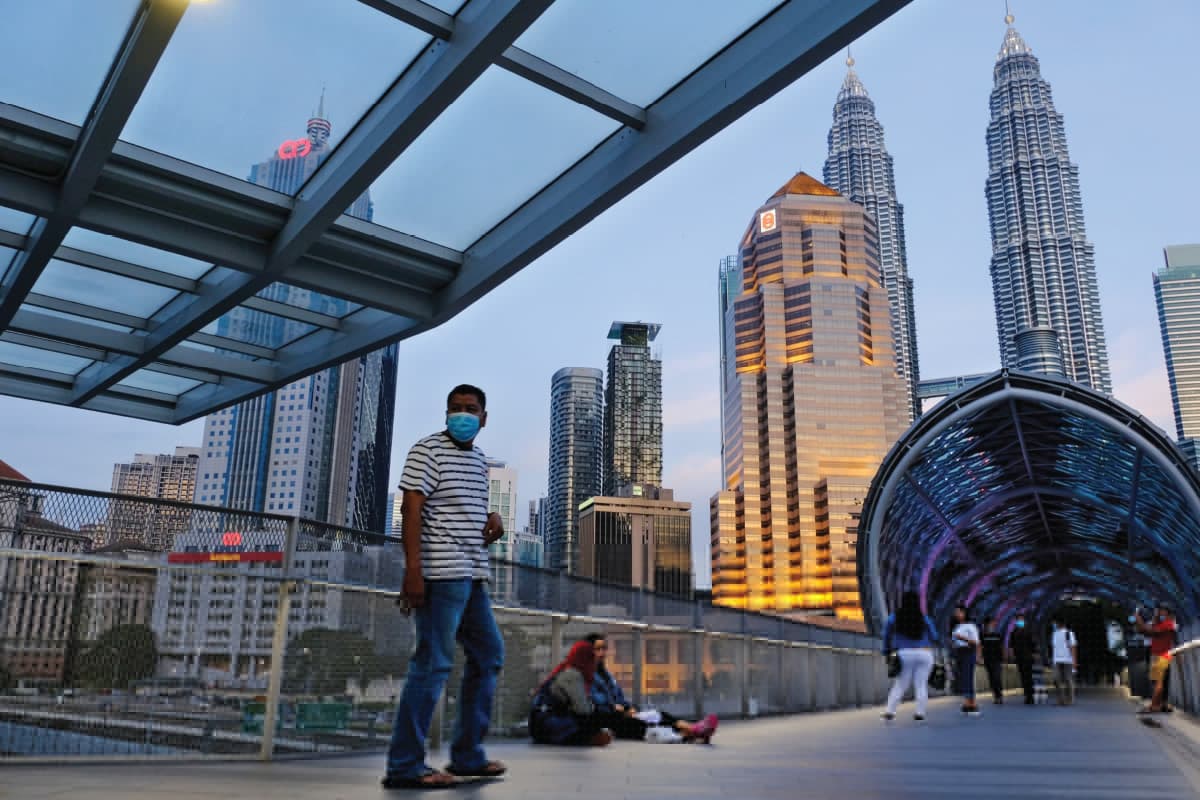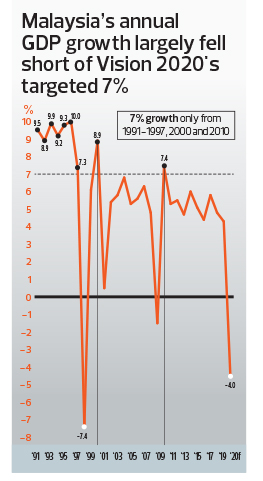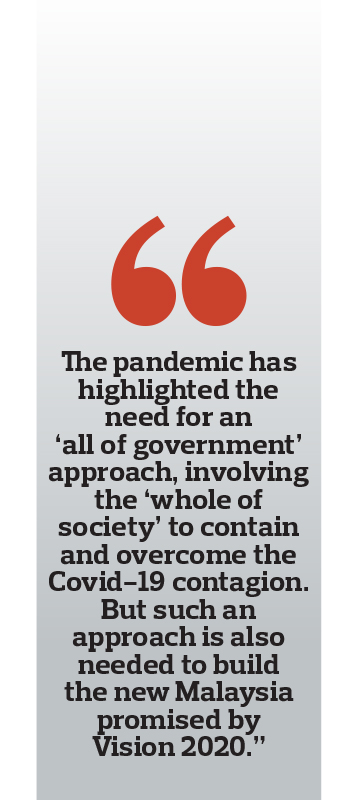
This article first appeared in The Edge Malaysia Weekly on December 28, 2020 - January 3, 2021
IN 2020, Malaysia was supposed to become a fully developed nation in every sense of the word. To borrow the words of Tun Dr Mahathir Mohamad when he presented Vision 2020 as the nation’s development goal three decades ago at the first meeting of the Malaysian Business Council on Feb 8, 1991: “Malaysia [by 2020] should not be developed only in the economic sense — It must be a nation that is fully developed along all the dimensions: economically, politically, socially, spiritually, psychologically and culturally. We must be fully developed in terms of national unity and social cohesion, in terms of our economy, in terms of social justice, political stability, system of government, quality of life, social and spiritual values, national pride and confidence.”
In a 90-minute interview with The Edge, 95-year-old Mahathir said he didn’t expect to be alive to see the year 2020, let alone be Malaysia’s prime minister in the first two months of the year before Covid-19 dominated the world’s agenda and forced policymakers to make tough decisions to save both lives and livelihoods. He also hadn’t expected to resign the way he did. He said he was left with no choice but to do so on Feb 24 and expressed deep concern over the impact of the current state of political affairs on the last leg of Malaysia’s race towards developed nation status (see interview on Pages 92 to 94).
Indeed, for most of 2020, Malaysia battled with the pandemic while coming to terms with the new political order — a ruling administration that Prime Minister Tan Sri Muhyiddin Yassin himself admitted on national broadcast to be one “not elected by the people” in the watershed 2018 general election, which ended the 61-year rule of the Barisan National (BN) coalition which had run the country since independence. BN component parties are part of the current Perikatan Nasional government alongside some former members of the Mahathir-led Pakatan Harapan government.
The country’s constitutional monarchy was also seen in new light in 2020, including when the national budget was recast as an avenue to demonstrate political clout in Malaysia’s parliamentary democracy.
On Dec 4, Malaysia’s sovereign rating saw its first downgrade since the 1997/98 Asian financial crisis (AFC) by Fitch Ratings, which reckons that the government’s “thin two-seat parliamentary majority implies persistent uncertainty about future policy” and that “deterioration in governance and continued political uncertainty could dampen investor sentiment, constraining economic growth”. Whether or not the view is shared by other rating agencies, Standard & Poor’s and Moody’s had not followed suit at the time of writing.
Tun Daim Zainuddin, who was finance minister when Vision 2020 was unveiled and chairman of The Council of Eminent Persons (CEP) advising Mahathir’s cabinet in 2018, attributed Fitch’s downgrade to ongoing uncertainties in his email interview with The Edge: “You can have a good economic recovery plan but it won’t make a major difference if [there is] no stability … Do we have good thinkers and administrators who can take charge of the situation?” Malaysia, he adds, needs to “get the best minds — irrespective of political leanings — and put a good plan in place to bring about the country’s recovery” because Malaysia needs a period where “real change and action can be taken without the need to pander to political ambitions. We should at least start the discussion” (see Q&A on Pages 95 to 97).
Malaysia has a lot of catching up to do in terms of headline GDP growth but more important are investments to secure the country’s competitive advantage and getting buy-in from businesses and the people. It remains to be seen whether the 12th Malaysia Plan to be tabled in early 2021 to prepare Malaysia for the post-pandemic world can reset the stage for growth to resume strongly.
Owing to the pandemic, Malaysia’s economy is expected to contract 4.5% in 2020 — the country’s third GDP contraction since Vision 2020 was announced in 1991 (after -7.4% in 1998 amid the AFC and -1.5% in 2009 amid the global financial crisis). The country’s GDP growth is expected to rebound between 6.5% and 7.5% in 2021. The economy grew 7.4% in 2010 after the GFC.
To achieve the US$16,000 per capita income aspired to in Vision 2020, the country needed to grow 7% a year over the 30-year period from 1991.
The goal was perhaps too ambitious to begin with — only China and Myanmar averaged more than 7% growth a year between 1991 and 2019, according to World Bank data. Vietnam and Laos averaged 6.9% and 6.8% respectively while Malaysia averaged 5.7%. The expected contraction of 4.5% in 2020 would reduce the average to 5.3% (which is incidentally the average growth between 2010 and 2019). Malaysia’s GDP growth did exceed 7% a year in the first seven years before the AFC but since then, has only exceeded 7% in 2000 and 2010.
An upper-middle income country since 1996, Malaysia’s per capita income of US$11,230 in 2019 is just shy of the US$12,535 threshold (as at July 1, 2020) that is needed to be deemed a high-income nation. A US$16,000 per capita income should be attainable within 10 years if Malaysia’s per capital income continues to grow at the average 4% a year that it did the past decade, a back-of-the-envelope calculation shows.
From the nine strategic goals, it is clear that Vision 2020 was never just about having high per capita income, though most developed countries were highly industrialised with a highly educated workforce.
South Korea — which reached the threshold of a lower-middle income country in 1969, the same year as Malaysia — attained upper-middle income status in 1988 and high-income status in 1995. Just four decades ago, in 1980, South Korea’s GDP per capita of US$1,715 was below Malaysia’s US$1,775. At the turn of the millennium, its GDP reached US$12,257 — triple Malaysia’s US$4,044 — a lead it continues to enjoy in 2019.
Mahathir and Daim both speak highly of South Korea’s former president Park Chung-hee, who supported a group of mostly family-run business conglomerates in the early 1960s, including Samsung and Hyundai, chaebols that are today not only well-recognised but also able to compete internationally. South Korea has spent more than 4% of its GDP on research and development since 2012, according to World Bank data. Samsung is the world’s biggest smartphone maker while Hyundai is among the companies that are stepping up the development of aerial vehicles as well as autonomous ships. Even before the pandemic hit, South Korea had allocated US$1.4 billion for the virtual reality content sector and a VR exhibition space in Seoul.
Malaysian companies sorely need to be competitive globally. “We are the biggest in the world for gloves … there are hundreds of rubber products that we can go into … but we are happy to sell our rubber raw … What we want to do is help people build big industries to serve the world, not serve the local market. That is what Japan, [South] Korea and China do,” Mahathir says.
As the year draws to a close, is Vision 2020 still relevant to the country’s development?
“Yes, very much so,” says Datuk Seri Dr Dzulkefly Ahmad, strategic director of the National Trust Party (Amanah), a component party of the Pakatan Harapan opposition coalition.
“Going by the evergreen, timeless, comprehensive and universal objectives of nation rebuilding, we do not need to waste more taxpayers’ money to engage top-notch international consultants to produce more plans, please. What we need is to see how we can undertake necessary reforms to achieve all the stipulated goals of Vision 2020 in perhaps 10 or 20 years,” the former health minister in the PH government tells The Edge.
“Going by the aspirations of Vision 2020 — couched in the idealised phrases of being a developed industrialised nation with a united Bangsa Malaysia (Malaysian race) — the Vision 2020 of Tun Dr Mahathir has undoubtedly and miserably failed. That is extremely unfortunate and regrettable. As a nation, we are a far cry from all those ideals that we set out to achieve by the close of 2020. That is very sad indeed,” adds Dzulkefly.
Economist Professor Jomo Kwame Sundaram, research adviser at the Khazanah Research Institute and Visiting Fellow at the Initiative for Policy Dialogue, Columbia University, who deems Vision 2020 to be “largely unrealised”, says “Vision 2020’s promise of a modern, industrialised, developed and united Malaysian nation remains more relevant than ever in many respects”.
“The pandemic has highlighted the need for an ‘all of government’ approach, involving the ‘whole of society’ to contain and overcome the Covid-19 contagion. But such an approach is also needed to build the new Malaysia promised by Vision 2020,” Jomo says, adding that Malaysia “will only recover better if the nation pulls together, instead of working against one another for short-term political advantage and personal economic gain”.
Beyond just talking and planning, Dzulkefly says Malaysia needs to make things happen and fast: “We need competent managers and passionate, selfless leaders. Arguably, we have a dearth of both. Quite on the contrary, we are oftentimes subverted by managers and leaders, who are driven by greed and dishonesty. Hence, we are plagued with kleptocracy and corruption. Moving forward, we can’t be doing ‘more of the same things’.”
Lastly, and perhaps most critically, what is lacking is the nation-building element of Bangsa Malaysia in Vision 2020.
“Despite all the hope of Vision 2020 to make Malaysia a mature democratic society and forging a scientific and progressive society, we have come to witness a more intolerant and fractious society, where the right-wing supremacist doctrine based on mono-ethnic and mono-religious views has raised its ugly head again. Identity politics has become more popular as a political persuasion and overtly subscribed and propagated by partisan political leaders. This underscores the importance of dismantling all forms of racial and religious bigotry, in this multiracial and multireligious nation, a prerequisite to enhancing mutual respect and forging a cohesive society. When all barriers of race and religion get to be torn down, in a truly inclusive society that practises mutual respect for ‘the other’, we will soon get to see a government capable of incentivising a functional and productive economic environment in place, effectively addressing the many economic disparities and inequalities in the society. A truly developed nation is not merely judged by its income per capita, but both by the level of cohesiveness, of material and non-material well-being and happiness indices of its citizenry,” Dzulkefly says.
Concurring with him are prominent economists Dr Nungsari Radhi and Emeritus Prof Datuk Dr Mohamed Ariff Abdul Kareem.
In an essay in Forum on Page 64, Nungsari writes: “The New Economic Policy (NEP), for example, morphed via some perverted logic into something else. Even today, it is discussed in terms of projects, contracts, quotas and licences.”
Ariff perhaps sums it up best in his essay “What went terribly wrong in Vision 2020” on Page 65 of Forum: “Malaysia is a multiracial country with a colourful diversity which represents its unique strength and competitive edge. It is a pity that this source of strength remains grossly underutilised.”
Save by subscribing to us for your print and/or digital copy.
P/S: The Edge is also available on Apple's App Store and Android's Google Play.



